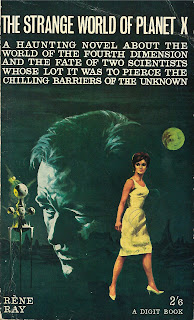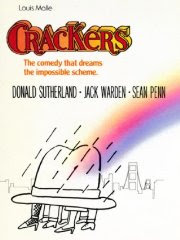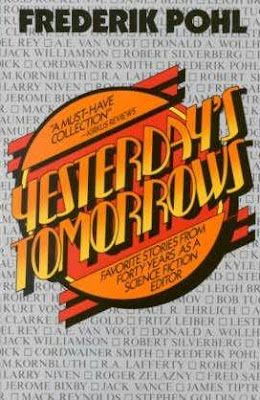Galaxy: debut issue, October 1950: World Editions: H.L. Gold, editor
***Galaxy magazine starts off with an issue drawing some of the most impressive writers already established in Astounding Science Fiction...with the exception of new writer Richard Matheson, whose second adult professional sale this was (after "Born of Man and Woman" in F&SF, and a bit of juvenilia in The Brooklyn Eagle some years. earlier)...and Fredric Brown, who was less a John W. Campbell "discovery" than the others, even more likely than they to publish his best work in a variety of magazines.
Robert Silverberg on Galaxy's first years:
Popular Publications: Mary Gnaedinger and Ejler Jakobsson, editors (and typos waiting to happen)
Mary Gnaedinger had been quietly mining back issues of Argosy and its stablemates since 1939 for her eventually, briefly three-magazine stable, and occasionally supplementing this reprints with fine original stories, such as Robert Bloch's "The Man Who Collected Poe" and Donald Wollheim's "Mimic" (which is reprinted in FN from an earlier FFM issue). But by the end of her magazines' run, she was able to spread her net farther, and draw in some impressive fiction from far beyond the back issues of the early pulps, including, in this issue, a novella by the author of Man's Fate, Andre Maurois. (The last issue of FFMwas to feature reprints of Kafka's "Metamorphosis" and Ayn Rand's goofy Anthem...)
Contents
The October 1950 Roll Call of US sf and fantasy fiction magazine titles:
A. MERRITT
***Galaxy magazine starts off with an issue drawing some of the most impressive writers already established in Astounding Science Fiction...with the exception of new writer Richard Matheson, whose second adult professional sale this was (after "Born of Man and Woman" in F&SF, and a bit of juvenilia in The Brooklyn Eagle some years. earlier)...and Fredric Brown, who was less a John W. Campbell "discovery" than the others, even more likely than they to publish his best work in a variety of magazines.
Robert Silverberg on Galaxy's first years:
It is impossible to overestimate the impact that Galaxy had on us in its first twelve or fifteen issues. There had never been such a succession of brilliant stories in an s-f magazine, not even in the Campbell Astounding of 1941, which had plenty of future classics but also a high percentage of pulp filler.
That first year of Galaxy left us all gasping, and I still look at those early issues with reverence and awe. It was as if Campbell’s whole stable had been holding in its best work, which Gold now was able to set free. Alas, by 1954 much of the magic was gone, and from 1955 on Galaxy was a good magazine indeed but no longer, well, astounding.
- Publication: Galaxy Science Fiction, October 1950
(View All Issues) (View Issue Grid) - Editors: H. L. Gold
- Year: 1950-10-00
- Publisher: World Editions, Inc.
- Price: $0.25
- Pages: 164
- Binding: digest
Contents
- 2 • For Adults Only • [Editor's Page (Galaxy)] • essay by H. L. Gold [as by The Editor ]
- 4 • Time Quarry (Part 1 of 3) • serial by Clifford D. Simak (book publication as Time and Again 1951)
- 4 • Time Quarry (Part 1 of 3) • interior artwork by David Stone
- 28 • Time Quarry (Part 1 of 3) [2] • interior artwork by David Stone
- 29 • Time Quarry (Part 1 of 3) [3] • interior artwork by David Stone
- 40 • Time Quarry (Part 1 of 3) [4] • interior artwork by David Stone
- 56 • Time Quarry (Part 1 of 3) [5] • interior artwork by David Stone
- 61 • Third from the Sun • shortstory by Richard Matheson
- 61 • Third from the Sun • interior artwork by Paul Callé [as by Callé ]
- 67 • Flying Saucers: Friend, Foe or Fantasy? • essay by Willy Ley
- 67 • Flying Saucers: Friend, Foe or Fantasy? • interior artwork by uncredited
- 72 • The Stars Are the Styx • novelette by Theodore Sturgeon
- 72 • The Stars Are the Styx • interior artwork by Paul Callé [as by Callé ]
- 107 • Forecast (Galaxy, October 1950) • essay by uncredited
- 108 • Later Than You Think • shortstory by Fritz Leiber
- 108 • Later Than You Think • interior artwork by uncredited
- 114 • Contagion • novelette by Katherine MacLean
- 114 • Contagion • interior artwork by Paul Pierre
- 141 • Galaxy's Five Star Shelf (Galaxy, October 1950) • [Galaxy's 5 Star Shelf] • essay by Groff Conklin
- 141 • Review: Shadow on the Hearth by Judith Merril • review by Groff Conklin
- 142 • Review: The Rat Race by Jay Franklin • review by Groff Conklin
- 143 • Review: Beyond Time and Space by August Derleth • review by Groff Conklin
- 143 • Review: Flight Into Space by Donald A. Wollheim • review by Groff Conklin
- 143 • Review: The Big Book of Science Fiction by Groff Conklin • review by Groff Conklin
- 144 • Review: Seven Science Fiction Novels of H. G. Wells by H. G. Wells • review by Groff Conklin
- 145 • The Last Martian • shortstory by Fredric Brown
- 152 • Darwinian Pool Room • shortstory by Isaac Asimov
- 152 • Darwinian Pool Room • interior artwork by uncredited
- bc • You'll Never See It in Galaxy • essay by H. L. Gold [as by uncredited]
Popular Publications: Mary Gnaedinger and Ejler Jakobsson, editors (and typos waiting to happen)
Mary Gnaedinger had been quietly mining back issues of Argosy and its stablemates since 1939 for her eventually, briefly three-magazine stable, and occasionally supplementing this reprints with fine original stories, such as Robert Bloch's "The Man Who Collected Poe" and Donald Wollheim's "Mimic" (which is reprinted in FN from an earlier FFM issue). But by the end of her magazines' run, she was able to spread her net farther, and draw in some impressive fiction from far beyond the back issues of the early pulps, including, in this issue, a novella by the author of Man's Fate, Andre Maurois. (The last issue of FFMwas to feature reprints of Kafka's "Metamorphosis" and Ayn Rand's goofy Anthem...)
- Publication: Famous Fantastic Mysteries, October 1950
(View All Issues) (View Issue Grid) - Editors: Mary Gnaedinger
- Year: 1950-10-00
- Publisher: All-Fiction Field, Inc.
- Price: $0.25
- Pages: 132
- Binding: pulp

- 6 • The Readers' Viewpoint (Famous Fantastic Mysteries, October 1950) • [The Readers' Viewpoint] • essay by Mary Gnaedinger
- 12 • The Woman Who Couldn't Die (Complete Novel) • serial by Arthur Stringer
- 12 • The Woman Who Couldn't Die (Complete Novel) • interior artwork by Virgil Finlay
- 34 • The Woman Who Couldn't Die (Complete Novel) [2] • interior artwork by Virgil Finlay
- 43 • The Woman Who Couldn't Die (Complete Novel) [3] • interior artwork by Virgil Finlay
- 53 • The Woman Who Couldn't Die (Complete Novel) [4] • interior artwork by Virgil Finlay
- 65 • The Woman Who Couldn't Die (Complete Novel) [5] • interior artwork by Virgil Finlay
- 84 • In Planders' Wood • poem by M. Ludington Cain
- 84 • In Planders' Wood • interior artwork by Lawrence
- 86 • The Weigher of Souls • (1931) • novella by André Maurois (trans. of Le peseur d'âmes)
- 86 • The Weigher of Souls • interior artwork by Lawrence
- 116 • Nor Moon by Night • shortstory by Peter Grainger [as by Peter Cartur ]
- 117 • Nor Moon by Night • interior artwork by Fawcette
- Publication: Fantastic Novels Magazine, September 1950
(View All Issues) (View Issue Grid) - Editors: Mary Gnaedinger
- Year: 1950-09-00
- Publisher: New Publications, Inc.
- Price: $0.25
- Pages: 132
- Binding: pulp
Contents:
- 6 • What Do You Think? (Fantastic Novels Magazine, September 1950) • [What Do You Think?] • essay by Mary Gnaedinger
- 10 • Polaris and the Goddess Glorian (Complete Novel) • [Polaris Janess • 3] • serial by Charles B. Stilson (book publication as Polaris and the Immortals 1968)
- 10 • Polaris and the Goddess Glorian (Complete Novel) • interior artwork by Frank R. Paul [as by Paul ]
- 39 • Polaris and the Goddess Glorian (Complete Novel) [2] • interior artwork by Frank R. Paul [as by Paul ]
- 61 • Polaris and the Goddess Glorian (Complete Novel) [3] • interior artwork by Frank R. Paul [as by Paul ]
- 84 • Polaris and the Goddess Glorian (Complete Novel) [4] • interior artwork by Frank R. Paul [as by Paul ]
- 110 • Friend Island • (1918) • shortstory by Francis Stevens
- 111 • Friend Island • interior artwork by Lawrence
- 118 • Mimic • (1942) • shortstory by Donald A. Wollheim
- 118 • Mimic • interior artwork by Lawrence
- 128 • Letter (Fantastic Novels Magazine, September 1950) • essay by Robert Silverberg [as by Bob Silverberg ]
- Publication: A. Merritt's Fantasy Magazine, October 1950
(View All Issues) (View Issue Grid) - Editors: Mary Gnaedinger
- Year: 1950-10-00
- Publisher: Recreational Reading, Inc.
- Price: $0.25
- Pages: 132
- Contents
- 6 • Calling All Fantasy Fans! (A. Merritt's Fantasy Magazine, October 1950) • essay by The Editor
- 10 • The Elixir of Hate (Complete Novel) • serial by George Allan England
- 10 • The Elixir of Hate (Complete Novel) • interior artwork by Lawrence [as by Sterne Stevens ]
- 27 • The Elixir of Hate (Complete Novel) [2] • interior artwork by Lawrence [as by Sterne Stevens ]
- 41 • The Elixir of Hate (Complete Novel) [3] • interior artwork by Lawrence [as by Sterne Stevens ]
- 91 • A Portrait of Abraham Merritt • essay by The Editor
- 91 • A Portrait of Abraham Merritt • interior artwork by Virgil Finlay
- 92 • The Devil-Fish • (1926) • shortstory by Elinore Cowan Stone
- 93 • The Devil-Fish • interior artwork by Virgil Finlay
- 100 • Racketeers in the Sky • (1940) • novelette by Jack Williamson
- 100 • Racketeers in the Sky • interior artwork by Paul Callé
- 121 • Readers' Column (A. Merritt's Fantasy Magazine, October 1950) • essay by The Editor
Super Science Stories had been founded in 1939 as one of the first two magazines (along with Astonishing Stories) edited by then 19yo Frederik Pohl, and the first two professional magazines to be edited by a member of the Futurian Society of New York, a highly productive and influential group of sf and fantasy writers, editors, artists and agents already showing great promise in their larval stages. As I've noted recently on the blog, they were trying to take the literary advances of the Tremaine and then Campbell Astounding further along, to the best of their abilities and within the budget restraints that their magazines allowed. But Pohl's magazines had been folded in 1943, in part due to WW2 paper shortages (which also led to the closure of Campbell's beloved fantasy magazine Unknown/Unknown Worlds). Popular Publications, seeing the postwar market as more friendly, relaunched SSS with staffer Ejler Jakobsson at the editor's desk, and it offered a fair amount of decent fiction by notable writers for its three years+ before folding again in 1951. Pohl was later amused that when he gave up his editorial position at the Galaxy magazine group in 1969, Jakobsson would be his successor at those magazines, as well.
- Publication: Super Science Stories, September 1950
- (View All Issues) (View Issue Grid)
- Editors: Ejler Jakobsson
- Year: 1950-09-00
- Publisher: Fictioneers, Inc.; Kokomo, IN
- Price: $0.25
- Pages: 132
- Binding: pulp
- Contents
- 10 • The Star Beast • novelette by Poul Anderson
- 10 • The Star Beast • interior artwork by Virgil Finlay
- 30 • Half-Life • shortstory by Alfred Coppel
- 39 • The Titan's Goblet • poem by Lilith Lorraine
- 40 • The Ultimate Quest • shortstory by Jack Vance (variant of Ultimate Quest) [as by John Holbrook
- 53 • The First • shortstory by Kris Neville
- 60 • The Undying Ones • shortstory by Fredric Brown (variant of Obedience)
- 70 • The Mind Masters • [Professor Jameson] • novelette by Neil R. Jones
- 99 • The Word from the Void • shortstory by Mack Reynolds
- 102 • Beyond Space and Time • (1938) • novelette by Joel Townsley Rogers
- 119 • Final Enemy • shortstory by L. Ron Hubbard

The October 1950 Roll Call of US sf and fantasy fiction magazine titles:
A. MERRITT
AMAZING
ASTOUNDING SF
AVON FANTASY READER
THE MAGAZINE OF FANTASY AND SCIENCE FICTION
FAMOUS FANTASTIC MYSTERIES
FANTASTIC ADVENTURES
FANTASTIC NOVELS
FANTASY BOOK
FANTASY FICTION
FUTURE
GALAXY
IMAGINATION
OTHER WORLDS
STARTLING STORIES
SUPER-SCIENCE STORIES
THRILLING WONDER
WEIRD TALES
WORLDS BEYOND


























































































